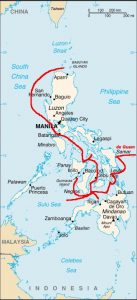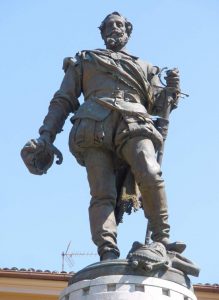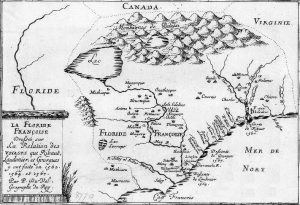Back to the New World (and a couple other places) this year. Here were the main developments of world-historical impact in 1564 CE:
- In Chile, the Mapuche continued their resistance to Spanish settler-colonialism though they continued to suffer grievously from Spanish violence. In March 1564, a conquistador captain called Lorenzo Bernal fought a battle at Angol against a Mapuche detachment led by the toqui (leader) Illangulién. English-WP, in an entry that relies almost exclusively on contemporary Spanish chronicles, tells us: “In the battle the Spanish drove the Mapuche out of their pukara [strongpoint]and pursued them down to the river bank and drove them into the river, where they were trapped and 1,000 Mapuches were killed, including the toqui Illanguelén, and many more were wounded or captured. Bernal ordered some of the captives killed and others lost hands or feet. When the news reached the rest of the Mapuche army coming to attack Angol, they dispersed.” Lost hands or feet? Excuse me?
 And elsewhere, on the Pacific coast of New Spain (today’s Mexico), another conquistador, Miguel López de Legazpi, was commissioned by the viceroy of New Spain in 1564 to establish a trading route between New Spain and the spices-rich East Indies. The explorers Ferdinand Magellan and Ruy López de Villalobos had made similar trans-Pacific voyages in 1521 and 1543, respectively– and along the way López de Villalobos had even named the islands he had reached in honor of Spain’s King Philip II! So in November 1564, this is the exploration project that López de Legazpi led: “Five ships, carrying 500 soldiers, sailed from the port of Barra de Navidad, New Spain, in what is now Jalisco state, Mexico… Members of the expedition included six Augustinian missionaries, in addition to Fr. Andrés de Urdaneta, who served as navigator and spiritual adviser; [a son and grandson of López de Legazpi]; and Guido de Lavezarez (a survivor of Ferdinand Magellan’s expedition).” They sailed for 93 days, eventually making landfall in the Mariana Islands, “where they briefly anchored and replenished their supplies. There they fought with Chamorro tribes and burned several huts.” Just conquistadores conquistadoring as usual, it seems.
And elsewhere, on the Pacific coast of New Spain (today’s Mexico), another conquistador, Miguel López de Legazpi, was commissioned by the viceroy of New Spain in 1564 to establish a trading route between New Spain and the spices-rich East Indies. The explorers Ferdinand Magellan and Ruy López de Villalobos had made similar trans-Pacific voyages in 1521 and 1543, respectively– and along the way López de Villalobos had even named the islands he had reached in honor of Spain’s King Philip II! So in November 1564, this is the exploration project that López de Legazpi led: “Five ships, carrying 500 soldiers, sailed from the port of Barra de Navidad, New Spain, in what is now Jalisco state, Mexico… Members of the expedition included six Augustinian missionaries, in addition to Fr. Andrés de Urdaneta, who served as navigator and spiritual adviser; [a son and grandson of López de Legazpi]; and Guido de Lavezarez (a survivor of Ferdinand Magellan’s expedition).” They sailed for 93 days, eventually making landfall in the Mariana Islands, “where they briefly anchored and replenished their supplies. There they fought with Chamorro tribes and burned several huts.” Just conquistadores conquistadoring as usual, it seems.-

Legazpi in Zumarraga, Spain In 1565, López de Legazpi would be named the “Governor-General of the Spanish East Indies.” Here’s how English-WP describes the legacy of his expedition: It “effectively created the trans-Pacific Manila galleon trade, in which silver mined from Mexico and Potosí was exchanged for Chinese silk, porcelain, Indonesian spices, Indian gems and other goods precious to Europe at the time. The trade route formed an important commercial link between Latin America and the Asia-Pacific with the trade products even carried over to Europe via the Havana Galleons, while heavily financing the Spanish Empire. The introduction of Western ingredients, goods, and imperialism brought about the ‘Hispanization’ of the islands. For the next 333 years, from 1565 when Spain first established a colony in the country until the Treaty of Paris on December 10, 1898, the Philippines was a Spanish colony (including the years 1762–1764 when the British controlled Manila and the port city of Cavite but not the whole country).” Iberian trade-routes now circled the whole globe.
-

17th century map of “French Florida” The Protestant French Huguenots were still having trouble establishing even a primitive colonial settlement in the Americas. Two years earlier, under Jean Ribault, they had tried at today’s Parris Island, SC. When that one failed Ribault’s followers fell back to a spot in the north-east of today’s Florida, where they established an outpost they named Fort Caroline. Some usual settler-colonial things happened: “For just over a year, this settlement was beset by hunger and desertion, and attracted the attention of Spanish authorities who considered it a challenge to their control over the area. The French colonists ‘had to rely heavily on the Indians’ for both food and trade. The Timucua welcomed them… Timucua chief Outina twice ‘coaxed the French into participating in attacks on villages of his rival, [the] Potano, to seize surplus corn.’ French soldiers who deserted from the fort raided Timucua settlements, souring relations with them… “
- And what was happening in Ming China meanwhile, you ask? All I can tell you is this: Eunuchs dropped peaches into the bed of the loony old Jiajing Emperor’s bed and “told him they fell from heaven.” And he “reduced all imperial clansmen to commoner status in response to their demand for stipends.” Given how venal, lecherous, and all-round weird this guy was, and the fact that he’d been in power since 1521, it is a strong testament to the stability of the empire’s professional administrative class that the whole empire had not fallen apart a long time earlier… (The banner image above is a 1538 painting of the Jiajing Emperor, painted on a scroll by unknown court artists.)
Also of note in 1564: Michaelangelo and John Calvin both died. And Galileo Galilei, Christopher Marlowe, and William Shakespeare were born.
